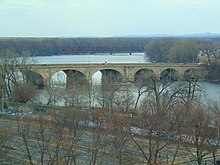Bulkeley Bridge
The flames started near the East Hartford end of the bridge, and within ten minutes had swept the entire tinder-dry structure.
[6] Backed by civic groups who saw an opportunity to create a monumental structure, construction on a permanent "Hartford Bridge" began in 1903.
To create a proper setting, the bridge commission tore down rows of tenements and constructed wide, landscaped approach boulevards on both sides of the river.
Constructed from over 100,000 cubic yards (76,000 m3) of grey and pink granite, each ten-ton block was cut to remarkable tolerances of within a 3/8ths of an inch.
Following a pair of horrific floods in 1936 and 1938 a series of levees were constructed along the banks of the Connecticut River, beginning Hartford's retreat from the waterfront and partially obscuring views of the bridge.
According to urban legend, Beatrice Fox Auerbach single-handedly decided that the two Interstates would meet at the western side of the Bulkeley Bridge without a direct connection.
This would force traffic to use local streets and conveniently have pass by the G. Fox & Co. department store (which was owned by Auerbach) in Downtown Hartford.
Until Riverfront Recapture efforts of the 1980s and 1990s, the bridge remained largely hidden from view behind the flood control dikes and highways.


